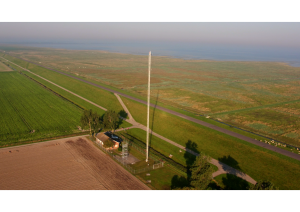 Features
Features
- Coastal, flat environment
- 60 m tower, remote sensing, in situ sensors
- Greenhouse gases, isotopes including 14C, Radon
- Precursor trace gases, aerosols, condensation nuclei
- Clouds
Background
Lutjewad is located on the Northern coast of The Netherlands, at 6º 21’ E, 53º 24’ N, 1 m above average sea level, directly situated behind the Wadden Sea dike. To the South the 60m tower is overlooking an almost perfectly flat rural landscape. Clean marine background air can reach the sampling tower during Northerly wind directions (16% of the time). Continental polluted air masses arrive with the prevalent south-east to south-westerly winds (50% of the time). Currently the site provides a high-quality record of all relevant greenhouse gases, as well as advanced tracers, such as carbon isotopes, 222Rn, O2/N2, COS. These allow to derive regional greenhouse gas emissions and estimates of biospheric and oceanic uptake of CO2. International data quality assessment and control requirements are implemented.
Rationale for including in the Ruisdael Observatory
Lutjewad is of crucial importance for
- Observing cloud-aerosol interactions over the coastal and marine environment. A combination of cloud, aerosol microphysics and chemistry measurements enables a detailed long-term aerosol-cloud interaction study and comparison with satellite measurements;
- Observing the regional evolution of aerosol. Baseline measurements during conditions of clean air inflow from the ocean are used for the estimation of the regional increment in aerosol concentration from the urbanized area in the “Randstad”. Lutjewad observations provide excellent data for studying the influence of new particle formation events on CCN concentrations in the outflow over the ocean;
- Observing and quantifying the Dutch anthropogenic greenhouse gas fluxes.
For the Ruisdael observatory, the extensive greenhouse gas measurements will be complemented by aerosol – cloud infrastructure. These will include cloud and aerosol profiling remote sensing instrumentation as well as in situ aerosol measurements. A ToF-ACSM will, beyond chemical characterization of the aerosol, also allow for source apportionment of the organic fraction. This ideally complements the 14C source apportionment methods which has been published and is in the process of updating.
Coordinator
Coordinator of the Lutjewad site is consortium partner University of Groningen.
Contact details: Uli Dusek or Bert Scheeren
Click here for the link to the station and real time data.
